Pop art (nonfiction)

Pop art is an art movement that emerged in the mid-1950s in Britain and the late 1950s in the United States.
Pop art is widely interpreted as a reaction to the then-dominant ideas of Abstract expressionism, as well as an expansion of those ideas.
Among the early artists that shaped the pop art movement were Eduardo Paolozzi and Richard Hamilton in Britain, and Robert Rauschenberg and Jasper Johns in the United States.
Pop art presented a challenge to traditions of fine art by including imagery from popular culture such as advertising and news. In pop art, material is sometimes visually removed from its known context, isolated, and/or combined with unrelated material.
Pop art employs aspects of mass culture, such as advertising, comic books and mundane cultural objects. One of its aims is to use images of popular (as opposed to elitist) culture in art, emphasizing the banal or kitschy elements of any culture, most often through the use of irony. It is also associated with the artists' use of mechanical means of reproduction or rendering techniques.
Pop art often takes imagery that is currently in use in advertising. Product labeling and logos figure prominently in the imagery chosen by pop artists, seen in the labels of Campbell's Soup Cans, by Andy Warhol.
In the News
Andy Warhol poses for picture, leaves the viewer to form their own opinion.
Fiction cross-reference
Nonfiction cross-reference
External links:
- Pop art @ Wikipedia
